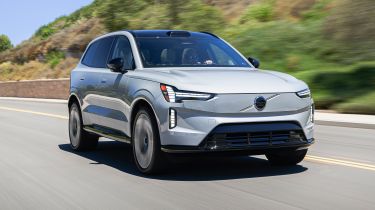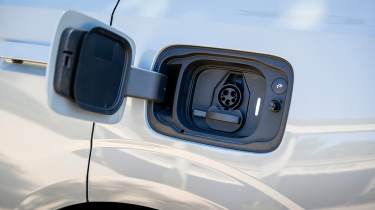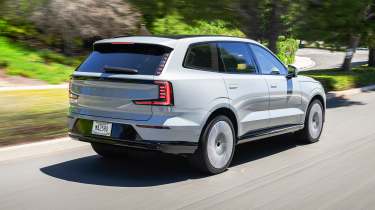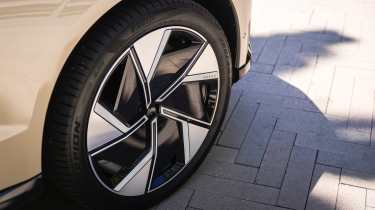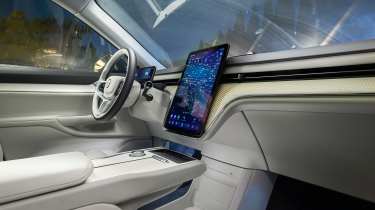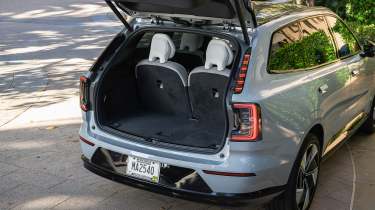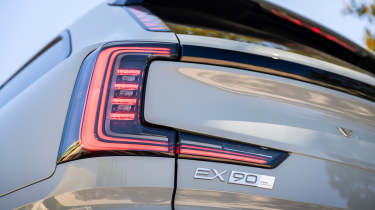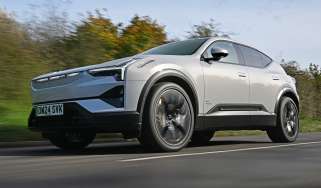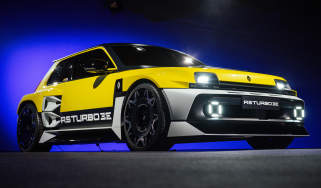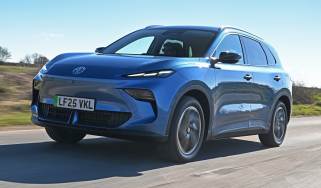Volvo EX90 review
Volvo’s electric seven-seater offers upmarket appeal along with practicality, but it’ll cost you plenty of money
Pros
- Plenty of space inside
- Quiet on the move
- Good to drive
Cons
- Nearly six-figures
- Rear seats are a bit snug
- Feels heavy when cornering
Volvo EX90 verdict
With a starting price of nearly £100,000, nobody is about to describe the Volvo EX90 as a bargain. What it is, though, is a premium yet family-friendly SUV which offers something that very few other electric SUVs currently have; seven seats. Your money doesn’t just go towards additional passenger space, though, as the EX90 is rammed full of safety features, along with top-quality materials. It’s surprisingly good to drive for its size and weight, too.
Range details, specs and alternatives
The combustion-powered Volvo XC90 is a steady seller, and while the facelifted version of this model will remain on sale for the time being, the Volvo EX90 is the very first of the Swedish brand’s large SUVs to be purely electric-powered.
In order to tempt the XC90’s loyal buyers into making the switch, the EX90 really needs to impress, and the pressure on Volvo’s new flagship only piles on further when you consider its near £97,000 starting price.
As a fully-electric seven-seater SUV, the Volvo EX90 finds itself in a sector of the market that’s all but deserted at present. While there are plenty of electric SUVs to choose from, only a handful offer the same number of seats as the Volvo. First there’s the Kia EV9, but this is being pitched as a much more mainstream offering, hence it’s £30,000 cheaper.
At the other end of the scale, there is one other premium seven-seater EV for the Volvo EX90 to contend with, and that is the Mercedes EQS SUV. While the Volvo’s near-£100,000 price is anything but small change, it still manages to undercut the Mercedes by around £30,000. Smaller, non-seven-seat premium EV rivals include the likes of the BMW iX.
The price gap between the Volvo and Mercedes is set to increase in future, too, as a cheaper single-motor EX90 is in the works. For now, though, there’s the choice of either a Twin Motor or Twin Motor Performance variant.
As you’ve probably guessed by the names, both versions are fitted with dual motors that drive all four wheels, and these are powered by a chunky 107kWh battery pack. Both versions also share the same official WLTP combined range of 374 miles.
Once you’ve decided on a powertrain, there’s only one trim level that’s currently available. This is called Ultra, and it includes plenty of kit to help solidify the EX90’s premium status. The star of the show inside is a 14.5-inch touchscreen display, and this is accompanied by a 25-speaker Bowers & Wilkins sound system along with plenty of plush materials. Elsewhere there’s kit including pixel-LED headlights, a heat pump and an array of safety tech (this is a Volvo, after all).
The EX90’s cabin is certainly a very comfortable and upmarket place to sit, and indeed it should be as the entry-level Twin Motor model will set you back by at least £96,255. Moving up to the Twin Motor Performance commands a £4,300 premium, which pushes this Volvo SUV over the £100,000 threshold.
Range, battery size & charging
| Model | Range | Wallbox charge time | Rapid charge |
| Twin Motor | 374 miles | 15hrs (0-100%, 7.4kW) | 30mins (10-80%, 250kW) |
| Twin Motor Performance | 374 miles | 15hrs (0-100%, 7.4kW) | 30mins (10-80%, 250kW) |
The Volvo EX90 is a very big and boxy SUV that weighs in at around 2.7 tonnes, but both variants still manage to claim a range of up to 374 miles on the WLTP combined cycle. While it’s not the slipperiest design in aerodynamic terms, Volvo’s electric seven-seater makes up for this with a sizeable 107kWh battery pack.
We achieved an average of nearly 3.0miles per kWh when testing the Volvo EX90 on the sun-soaked roads of the American West Coast, and this equates to around 320 miles of range. This is a respectable real-world figure, but the unpredictability of British weather could cause this to drop, especially in the winter months. Fortunately, there’s a standard-fit heat pump to help keep the cold at bay.
When it’s time to top up, the EX90 can be recharged from 10-80% in just 30 minutes thanks to its 250kW DC rapid charging capability. A full charge at home from a typical 7.4kW wallbox charger will need to be pre-planned, though, as this takes around 16 hours.
Running costs & insurance
If you’re prepared to hand over around £100,000 for a family SUV, we doubt that high insurance costs will be too much of a concern. It’s a good job, too, as both variants of the Volvo EX90 sit in insurance group 50, so those premiums won’t come cheap.
Of course, being an electric car, there are still plenty of savings to be had when it comes to charging and taxing the big Volvo. At a typical household rate of 30p per kWh, the EX90’s 107kWh battery will cost around £32 to fully charge. That’s far cheaper than filling up the equivalent XC90 with petrol or diesel.
Those in need of a family-friendly yet luxurious company car will reap the benefits, too, as the Volvo EX90 only incurs a 2% Benefit-in-Kind tax rate. All EX90 drivers can also enjoy zero VED road tax until April 2025, as well as avoiding low emission zone charges.
Performance, motor & drive
| Model | 0-62mph | Top speed | Driven wheels | Power |
| Twin Motor | 5.9s | 112mph | Four | 402bhp |
| Twin Motor Performance | 4.9s | 112mph | Four | 510bhp |
As you’d understandably expect from such a plush and pricey EV, the Volvo EX90 is very quiet and refined on the move. Keep the windows closed and the cabin does an excellent job of shielding its occupants from the harsh sounds of the outside world, while the dual-motor powertrain operates in a hushed manner.
The only noticeable sounds are at motorway speeds, as there’s a bit of wind whistle from the door mirrors and a light rumble from the 22-inch wheels. Neither of these is anywhere near enough to spoil the ambience, though.
The Volvo EX90 is the polar opposite of a traditional sports car, but this lavish seven-seater still manages to perform admirably when you want to get a real move on. Even the entry-level Twin Motor packs 402bhp and 770Nm of torque, and this allows it to sprint from 0-62mph in 5.9 seconds. Naturally, the Twin Motor Performance boosts the powertrain’s output even further to 510bhp and 910Nm, and this shaves an entire second off the 0-62mph time. Both cars max out at 112mph.
When you aim it towards a corner, you’ll quickly remember that the Volvo EX90 is a 2.7-tonne SUV, but the air suspension helps to keep body roll under a reasonable amount of control. When you want things to settle down again, the brakes are reassuringly strong while the regenerative braking system offers the choice of single-pedal driving.
Interior, dashboard & infotainment
It’s inside where the Volvo EX90 arguably makes the strongest case for its considerable price tag. As with a number of EVs at this end of the market, the cabin has a minimalist feel that’s not too dissimilar to the smaller EX30.
At the centre of the dashboard resides a 14.5-inch touchscreen running Android Automotive software. This isn’t to be confused with Android Auto connectivity, though, as the brand is yet to add this via an over-the-air update (along with Apple CarPlay). Fortunately the existing software is very responsive and easy to use, and the 25-speaker Bowers & Wilkins system truly sounds fantastic.
A number of the Volvo EX90's advanced driver assistance systems will also be added via a free update later on in the car’s lifetime, and this is simply because they are not ready yet. We can’t help but find this a little bit disappointing.
While the Volvo EX30 is marred by an over-reliance on its centre touchscreen, the EX90 offers far more functionality, such as a separate driver’s instrumentation screen and a head-up display.
Boot space, seating & practicality
| Length | Width | Height | Boot space (rear seats up/down) |
| 5,037mm | 2,113mm | 1,747mm | 310/1,915 litres |
The Volvo EX90 is a big electric car with a suitably generous amount of space inside. Even with all seven seats in place, there’s still 310 litres of boot space on offer, which is exactly the same capacity as you’ll find in a Citroen e-C3 supermini. Fold the rear and middle seats down, though, and you’ll have a van-like 1,915 litres at your disposal.
As is often the case with seven-seater cars, taller passengers will find the EX90’s rearmost seats a bit snug, especially on longer journeys. Keep these reserved for the kids, though, and they should be just fine. Volvo has fitted ISOFIX points to these seats, too, which is quite a rare sight on a seven-seater.
Things start to improve when moving forward to the middle row, where there’s plenty of headroom. Legroom is best described as sufficient rather than luxurious, though. If you want to stretch out, these seats can slide backwards, but passengers in the rear seats won’t be too pleased.
It’s the front passenger and driver who can expect to enjoy the life of luxury in the Volvo EX90, as it’s here where there’s legroom and headroom to spare.
Reliability & safety rating
Volvo has become a byword for safety over the decades, so the brand won’t want its latest flagship to be the car that spoils this reputation. The Volvo EX90 is yet to be tested by Euro NCAP, but there’s a plethora of standard safety tech that should help towards that coveted five-star rating.
A side-impact protection system, whiplash protection system, road-sign information display, blind-spot detection, steer assist, eye tracking, cross-traffic alert, intelligent speed assist, run-off road protection and a multitude of airbags are just some of the systems that will help to keep the EX90’s occupants safe and sound. Unfortunately, though, some tech, such as the LIDAR system, is yet to be added via an over-the-air update.
The Volvo EX90 is far too new for us to determine its reliability just yet, but Volvo’s performance in our 2024 Driver Power owner satisfaction survey was only average, as it placed 16 out of 32 manufacturers. The Volvo XC40 was the brand’s sole model to appear in our Driver Power car rankings, too, finishing in 32nd place out of 75.

